Project Management Transport for London Project Brief
VerifiedAdded on 2023/06/17
|12
|2009
|196
AI Summary
This report covers initiation, network diagram, stakeholder analysis, WBS, and risk analysis for productivity enhancement of project. The project is regarding building of 800 homes in action by TFL which is helping in developing organisation activities and performance.
Contribute Materials
Your contribution can guide someone’s learning journey. Share your
documents today.
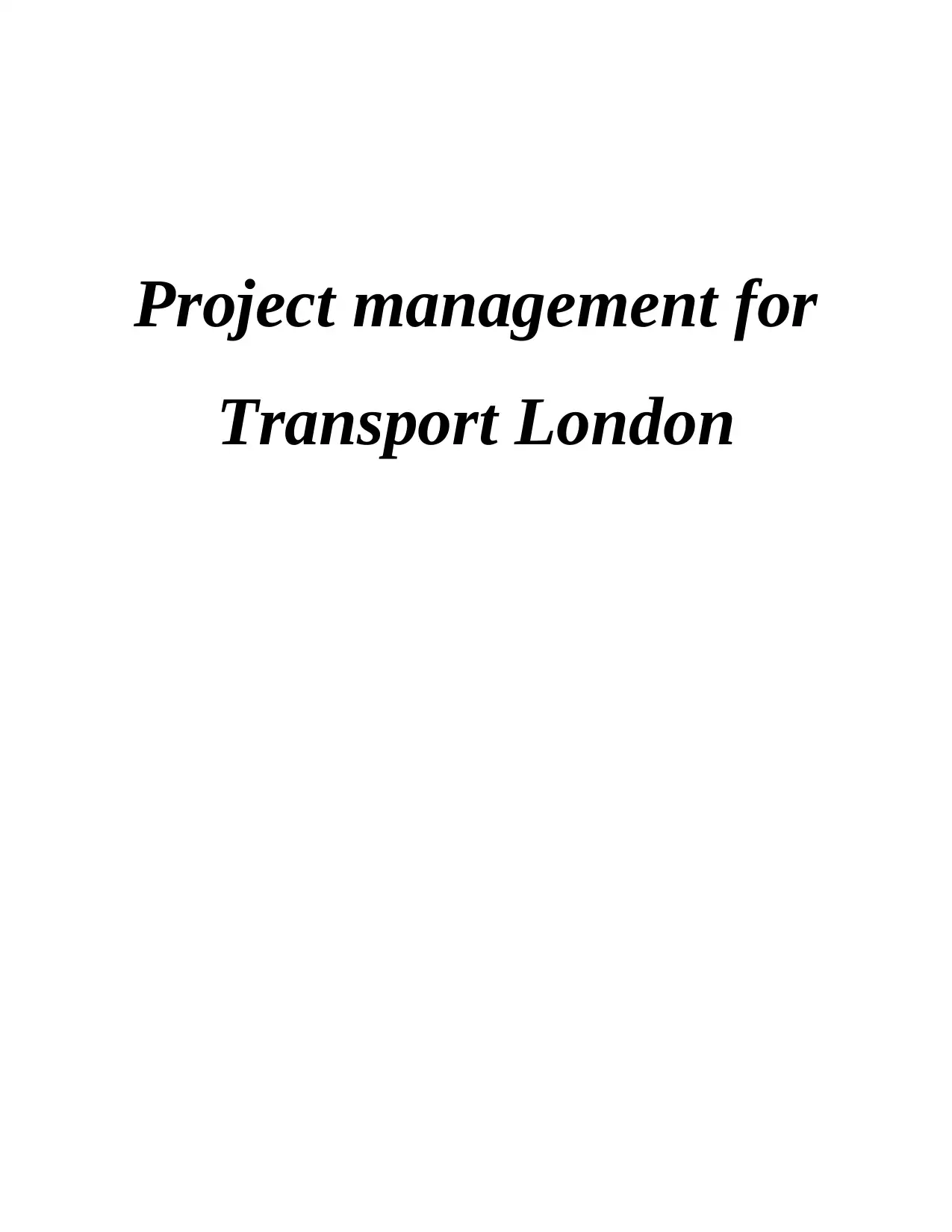
Project management for
Transport London
Transport London
Secure Best Marks with AI Grader
Need help grading? Try our AI Grader for instant feedback on your assignments.
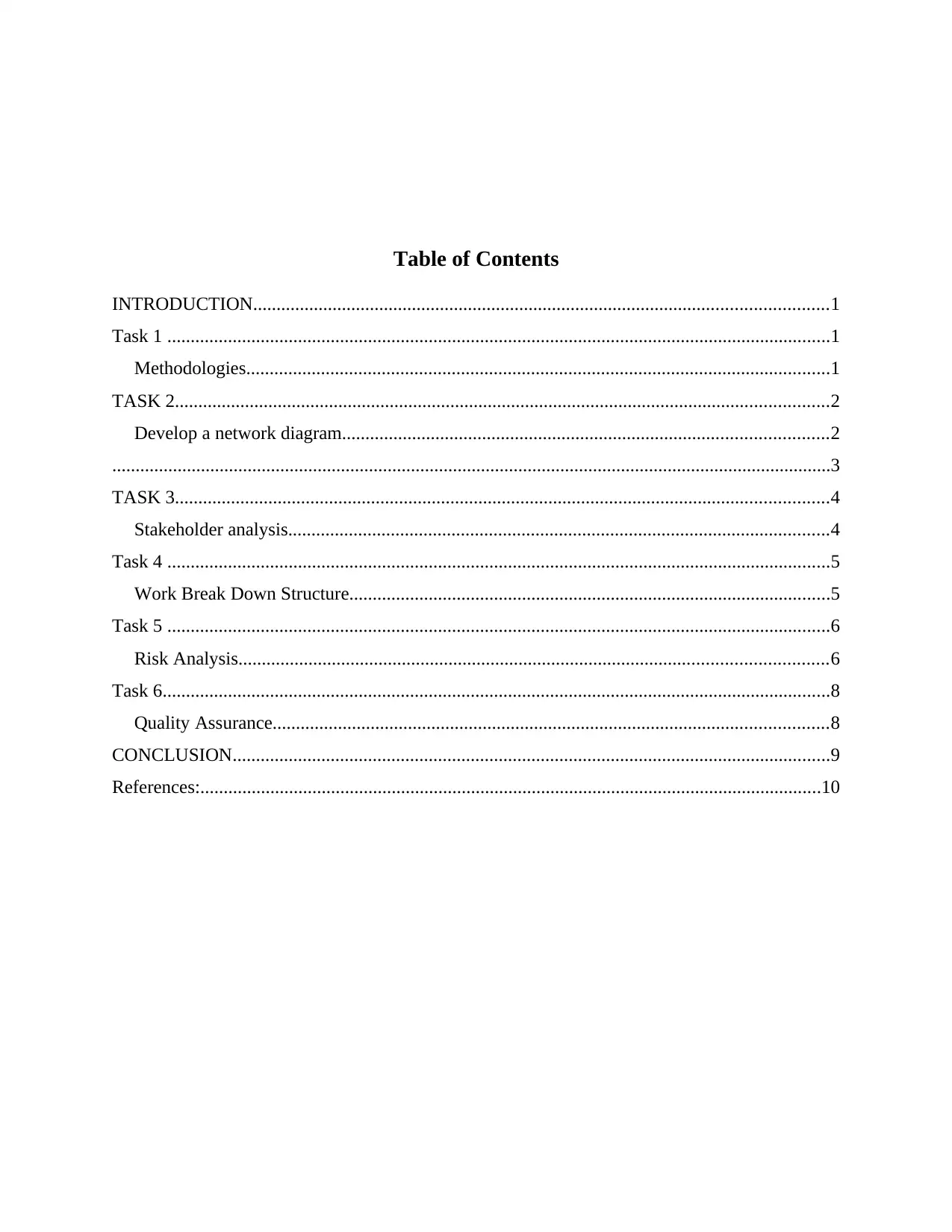
Table of Contents
INTRODUCTION...........................................................................................................................1
Task 1 ..............................................................................................................................................1
Methodologies.............................................................................................................................1
TASK 2............................................................................................................................................2
Develop a network diagram........................................................................................................2
..........................................................................................................................................................3
TASK 3............................................................................................................................................4
Stakeholder analysis....................................................................................................................4
Task 4 ..............................................................................................................................................5
Work Break Down Structure.......................................................................................................5
Task 5 ..............................................................................................................................................6
Risk Analysis..............................................................................................................................6
Task 6...............................................................................................................................................8
Quality Assurance.......................................................................................................................8
CONCLUSION................................................................................................................................9
References:.....................................................................................................................................10
INTRODUCTION...........................................................................................................................1
Task 1 ..............................................................................................................................................1
Methodologies.............................................................................................................................1
TASK 2............................................................................................................................................2
Develop a network diagram........................................................................................................2
..........................................................................................................................................................3
TASK 3............................................................................................................................................4
Stakeholder analysis....................................................................................................................4
Task 4 ..............................................................................................................................................5
Work Break Down Structure.......................................................................................................5
Task 5 ..............................................................................................................................................6
Risk Analysis..............................................................................................................................6
Task 6...............................................................................................................................................8
Quality Assurance.......................................................................................................................8
CONCLUSION................................................................................................................................9
References:.....................................................................................................................................10
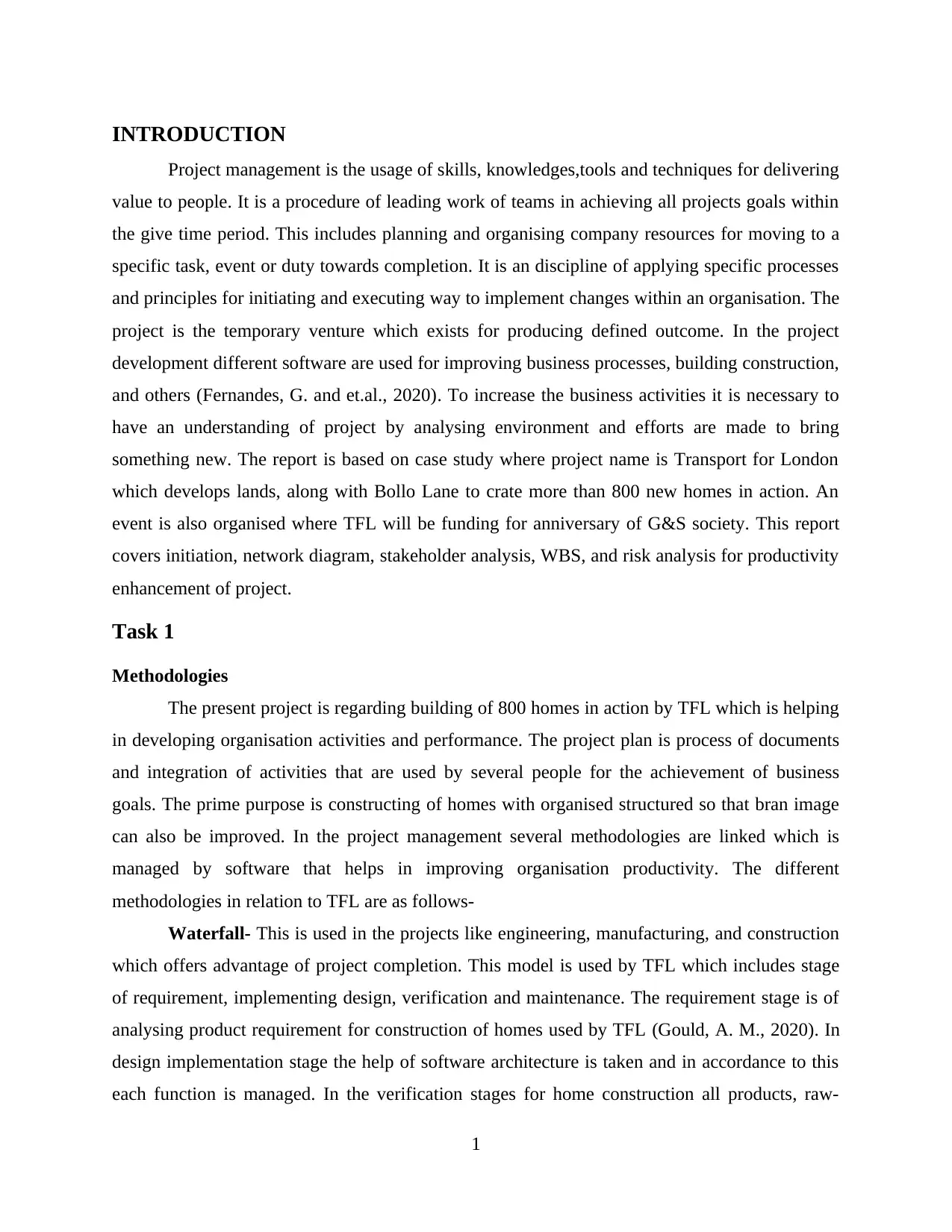
INTRODUCTION
Project management is the usage of skills, knowledges,tools and techniques for delivering
value to people. It is a procedure of leading work of teams in achieving all projects goals within
the give time period. This includes planning and organising company resources for moving to a
specific task, event or duty towards completion. It is an discipline of applying specific processes
and principles for initiating and executing way to implement changes within an organisation. The
project is the temporary venture which exists for producing defined outcome. In the project
development different software are used for improving business processes, building construction,
and others (Fernandes, G. and et.al., 2020). To increase the business activities it is necessary to
have an understanding of project by analysing environment and efforts are made to bring
something new. The report is based on case study where project name is Transport for London
which develops lands, along with Bollo Lane to crate more than 800 new homes in action. An
event is also organised where TFL will be funding for anniversary of G&S society. This report
covers initiation, network diagram, stakeholder analysis, WBS, and risk analysis for productivity
enhancement of project.
Task 1
Methodologies
The present project is regarding building of 800 homes in action by TFL which is helping
in developing organisation activities and performance. The project plan is process of documents
and integration of activities that are used by several people for the achievement of business
goals. The prime purpose is constructing of homes with organised structured so that bran image
can also be improved. In the project management several methodologies are linked which is
managed by software that helps in improving organisation productivity. The different
methodologies in relation to TFL are as follows-
Waterfall- This is used in the projects like engineering, manufacturing, and construction
which offers advantage of project completion. This model is used by TFL which includes stage
of requirement, implementing design, verification and maintenance. The requirement stage is of
analysing product requirement for construction of homes used by TFL (Gould, A. M., 2020). In
design implementation stage the help of software architecture is taken and in accordance to this
each function is managed. In the verification stages for home construction all products, raw-
1
Project management is the usage of skills, knowledges,tools and techniques for delivering
value to people. It is a procedure of leading work of teams in achieving all projects goals within
the give time period. This includes planning and organising company resources for moving to a
specific task, event or duty towards completion. It is an discipline of applying specific processes
and principles for initiating and executing way to implement changes within an organisation. The
project is the temporary venture which exists for producing defined outcome. In the project
development different software are used for improving business processes, building construction,
and others (Fernandes, G. and et.al., 2020). To increase the business activities it is necessary to
have an understanding of project by analysing environment and efforts are made to bring
something new. The report is based on case study where project name is Transport for London
which develops lands, along with Bollo Lane to crate more than 800 new homes in action. An
event is also organised where TFL will be funding for anniversary of G&S society. This report
covers initiation, network diagram, stakeholder analysis, WBS, and risk analysis for productivity
enhancement of project.
Task 1
Methodologies
The present project is regarding building of 800 homes in action by TFL which is helping
in developing organisation activities and performance. The project plan is process of documents
and integration of activities that are used by several people for the achievement of business
goals. The prime purpose is constructing of homes with organised structured so that bran image
can also be improved. In the project management several methodologies are linked which is
managed by software that helps in improving organisation productivity. The different
methodologies in relation to TFL are as follows-
Waterfall- This is used in the projects like engineering, manufacturing, and construction
which offers advantage of project completion. This model is used by TFL which includes stage
of requirement, implementing design, verification and maintenance. The requirement stage is of
analysing product requirement for construction of homes used by TFL (Gould, A. M., 2020). In
design implementation stage the help of software architecture is taken and in accordance to this
each function is managed. In the verification stages for home construction all products, raw-
1
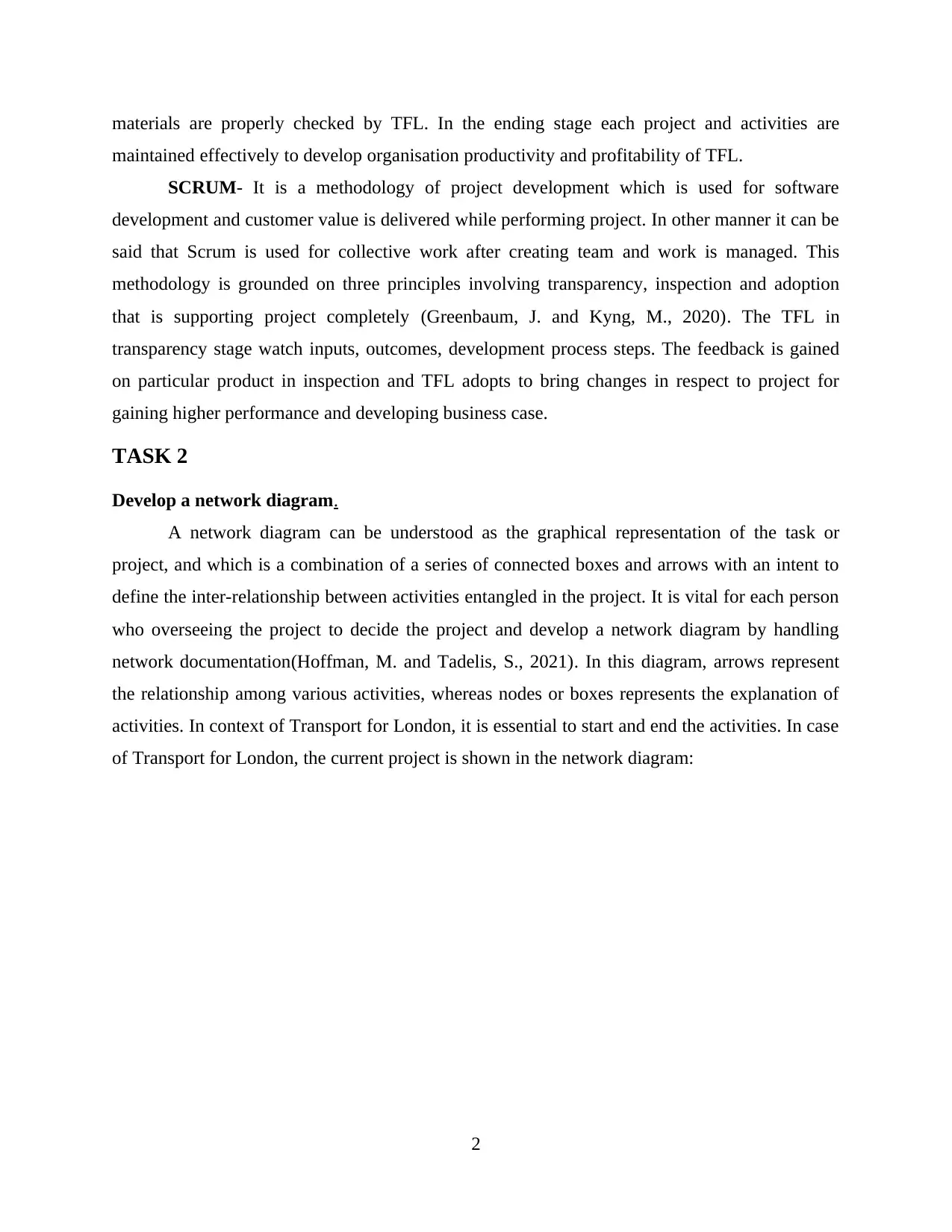
materials are properly checked by TFL. In the ending stage each project and activities are
maintained effectively to develop organisation productivity and profitability of TFL.
SCRUM- It is a methodology of project development which is used for software
development and customer value is delivered while performing project. In other manner it can be
said that Scrum is used for collective work after creating team and work is managed. This
methodology is grounded on three principles involving transparency, inspection and adoption
that is supporting project completely (Greenbaum, J. and Kyng, M., 2020). The TFL in
transparency stage watch inputs, outcomes, development process steps. The feedback is gained
on particular product in inspection and TFL adopts to bring changes in respect to project for
gaining higher performance and developing business case.
TASK 2
Develop a network diagram.
A network diagram can be understood as the graphical representation of the task or
project, and which is a combination of a series of connected boxes and arrows with an intent to
define the inter-relationship between activities entangled in the project. It is vital for each person
who overseeing the project to decide the project and develop a network diagram by handling
network documentation(Hoffman, M. and Tadelis, S., 2021). In this diagram, arrows represent
the relationship among various activities, whereas nodes or boxes represents the explanation of
activities. In context of Transport for London, it is essential to start and end the activities. In case
of Transport for London, the current project is shown in the network diagram:
2
maintained effectively to develop organisation productivity and profitability of TFL.
SCRUM- It is a methodology of project development which is used for software
development and customer value is delivered while performing project. In other manner it can be
said that Scrum is used for collective work after creating team and work is managed. This
methodology is grounded on three principles involving transparency, inspection and adoption
that is supporting project completely (Greenbaum, J. and Kyng, M., 2020). The TFL in
transparency stage watch inputs, outcomes, development process steps. The feedback is gained
on particular product in inspection and TFL adopts to bring changes in respect to project for
gaining higher performance and developing business case.
TASK 2
Develop a network diagram.
A network diagram can be understood as the graphical representation of the task or
project, and which is a combination of a series of connected boxes and arrows with an intent to
define the inter-relationship between activities entangled in the project. It is vital for each person
who overseeing the project to decide the project and develop a network diagram by handling
network documentation(Hoffman, M. and Tadelis, S., 2021). In this diagram, arrows represent
the relationship among various activities, whereas nodes or boxes represents the explanation of
activities. In context of Transport for London, it is essential to start and end the activities. In case
of Transport for London, the current project is shown in the network diagram:
2
Secure Best Marks with AI Grader
Need help grading? Try our AI Grader for instant feedback on your assignments.
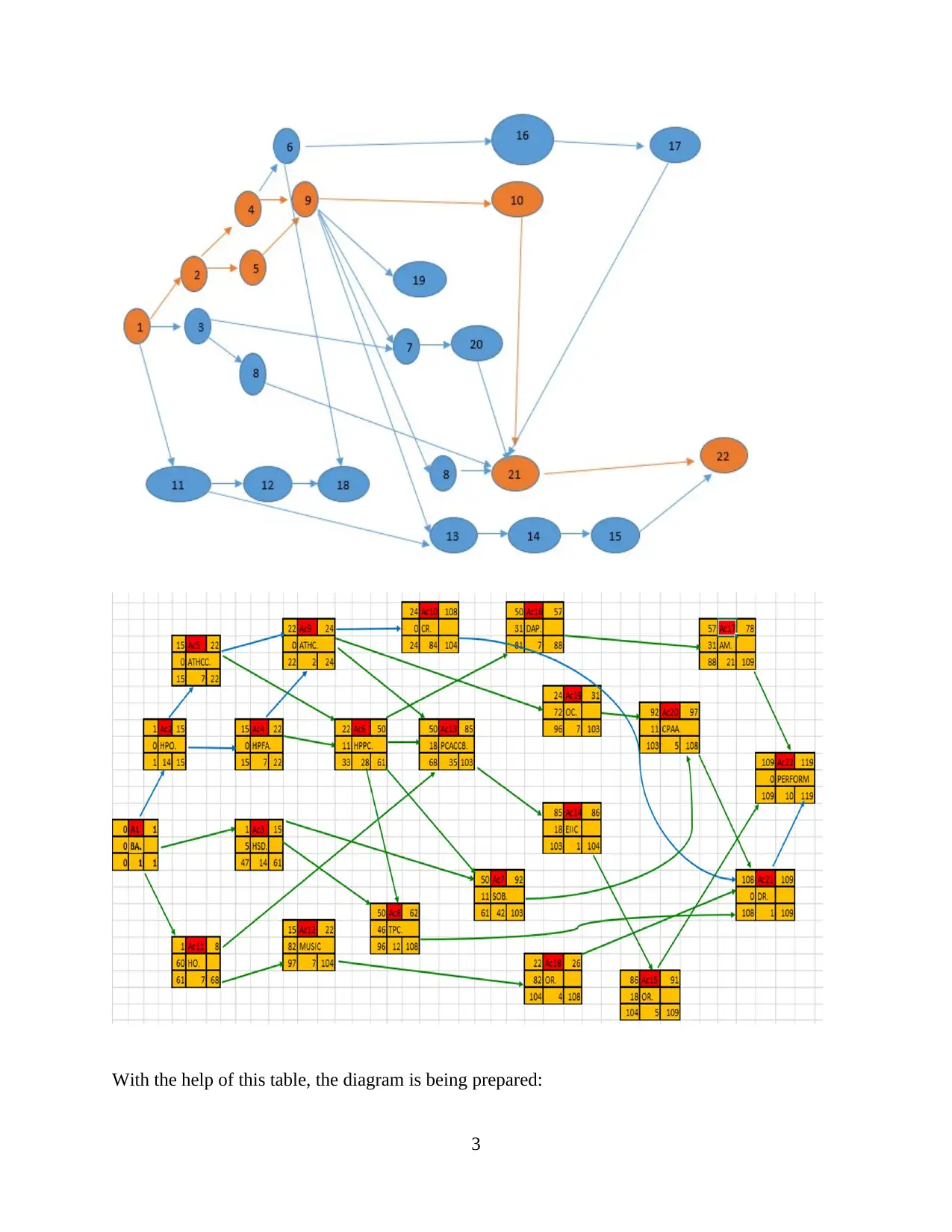
With the help of this table, the diagram is being prepared:
3
3
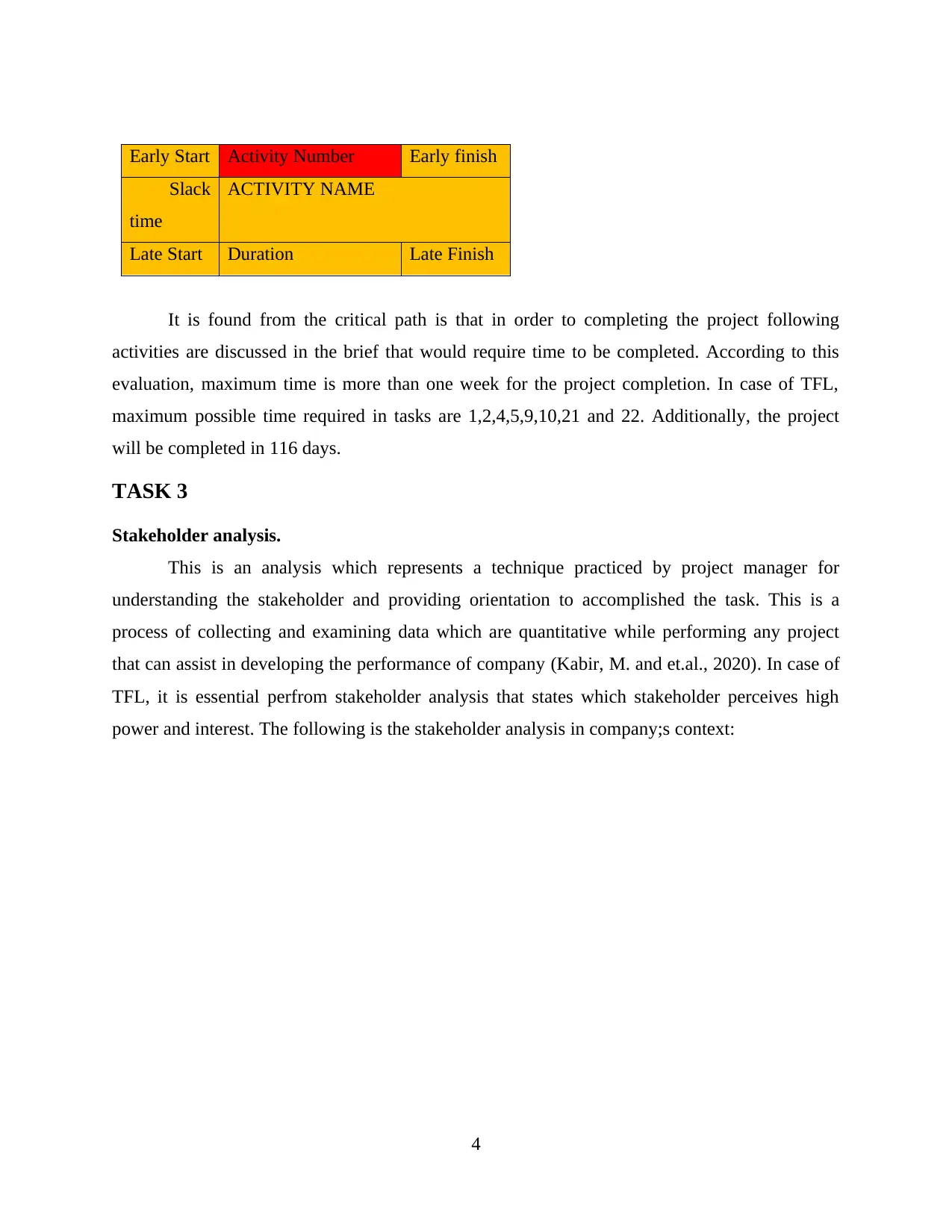
Early Start Activity Number Early finish
Slack
time
ACTIVITY NAME
Late Start Duration Late Finish
It is found from the critical path is that in order to completing the project following
activities are discussed in the brief that would require time to be completed. According to this
evaluation, maximum time is more than one week for the project completion. In case of TFL,
maximum possible time required in tasks are 1,2,4,5,9,10,21 and 22. Additionally, the project
will be completed in 116 days.
TASK 3
Stakeholder analysis.
This is an analysis which represents a technique practiced by project manager for
understanding the stakeholder and providing orientation to accomplished the task. This is a
process of collecting and examining data which are quantitative while performing any project
that can assist in developing the performance of company (Kabir, M. and et.al., 2020). In case of
TFL, it is essential perfrom stakeholder analysis that states which stakeholder perceives high
power and interest. The following is the stakeholder analysis in company;s context:
4
Slack
time
ACTIVITY NAME
Late Start Duration Late Finish
It is found from the critical path is that in order to completing the project following
activities are discussed in the brief that would require time to be completed. According to this
evaluation, maximum time is more than one week for the project completion. In case of TFL,
maximum possible time required in tasks are 1,2,4,5,9,10,21 and 22. Additionally, the project
will be completed in 116 days.
TASK 3
Stakeholder analysis.
This is an analysis which represents a technique practiced by project manager for
understanding the stakeholder and providing orientation to accomplished the task. This is a
process of collecting and examining data which are quantitative while performing any project
that can assist in developing the performance of company (Kabir, M. and et.al., 2020). In case of
TFL, it is essential perfrom stakeholder analysis that states which stakeholder perceives high
power and interest. The following is the stakeholder analysis in company;s context:
4
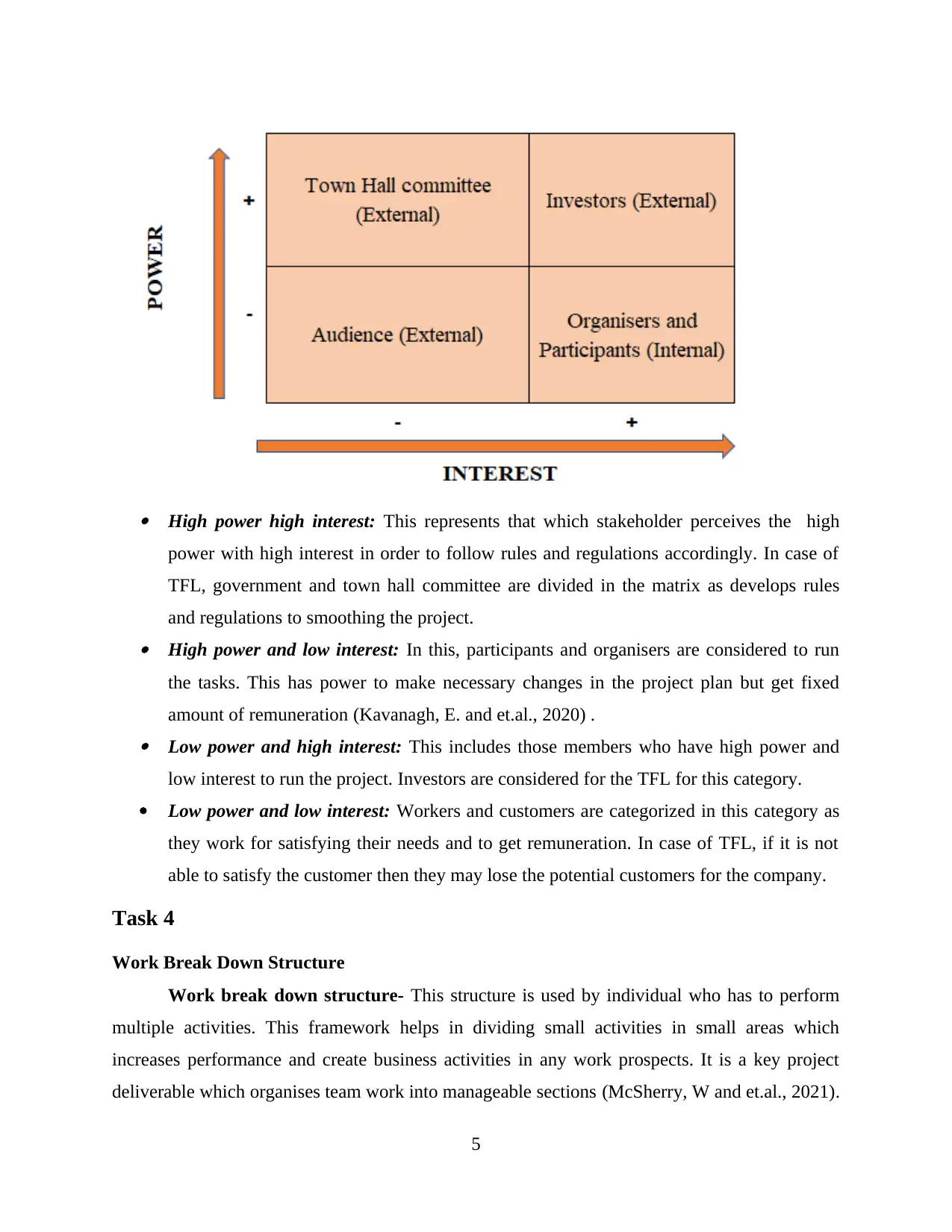
High power high interest: This represents that which stakeholder perceives the high
power with high interest in order to follow rules and regulations accordingly. In case of
TFL, government and town hall committee are divided in the matrix as develops rules
and regulations to smoothing the project. High power and low interest: In this, participants and organisers are considered to run
the tasks. This has power to make necessary changes in the project plan but get fixed
amount of remuneration (Kavanagh, E. and et.al., 2020) . Low power and high interest: This includes those members who have high power and
low interest to run the project. Investors are considered for the TFL for this category.
Low power and low interest: Workers and customers are categorized in this category as
they work for satisfying their needs and to get remuneration. In case of TFL, if it is not
able to satisfy the customer then they may lose the potential customers for the company.
Task 4
Work Break Down Structure
Work break down structure- This structure is used by individual who has to perform
multiple activities. This framework helps in dividing small activities in small areas which
increases performance and create business activities in any work prospects. It is a key project
deliverable which organises team work into manageable sections (McSherry, W and et.al., 2021).
5
power with high interest in order to follow rules and regulations accordingly. In case of
TFL, government and town hall committee are divided in the matrix as develops rules
and regulations to smoothing the project. High power and low interest: In this, participants and organisers are considered to run
the tasks. This has power to make necessary changes in the project plan but get fixed
amount of remuneration (Kavanagh, E. and et.al., 2020) . Low power and high interest: This includes those members who have high power and
low interest to run the project. Investors are considered for the TFL for this category.
Low power and low interest: Workers and customers are categorized in this category as
they work for satisfying their needs and to get remuneration. In case of TFL, if it is not
able to satisfy the customer then they may lose the potential customers for the company.
Task 4
Work Break Down Structure
Work break down structure- This structure is used by individual who has to perform
multiple activities. This framework helps in dividing small activities in small areas which
increases performance and create business activities in any work prospects. It is a key project
deliverable which organises team work into manageable sections (McSherry, W and et.al., 2021).
5
Paraphrase This Document
Need a fresh take? Get an instant paraphrase of this document with our AI Paraphraser
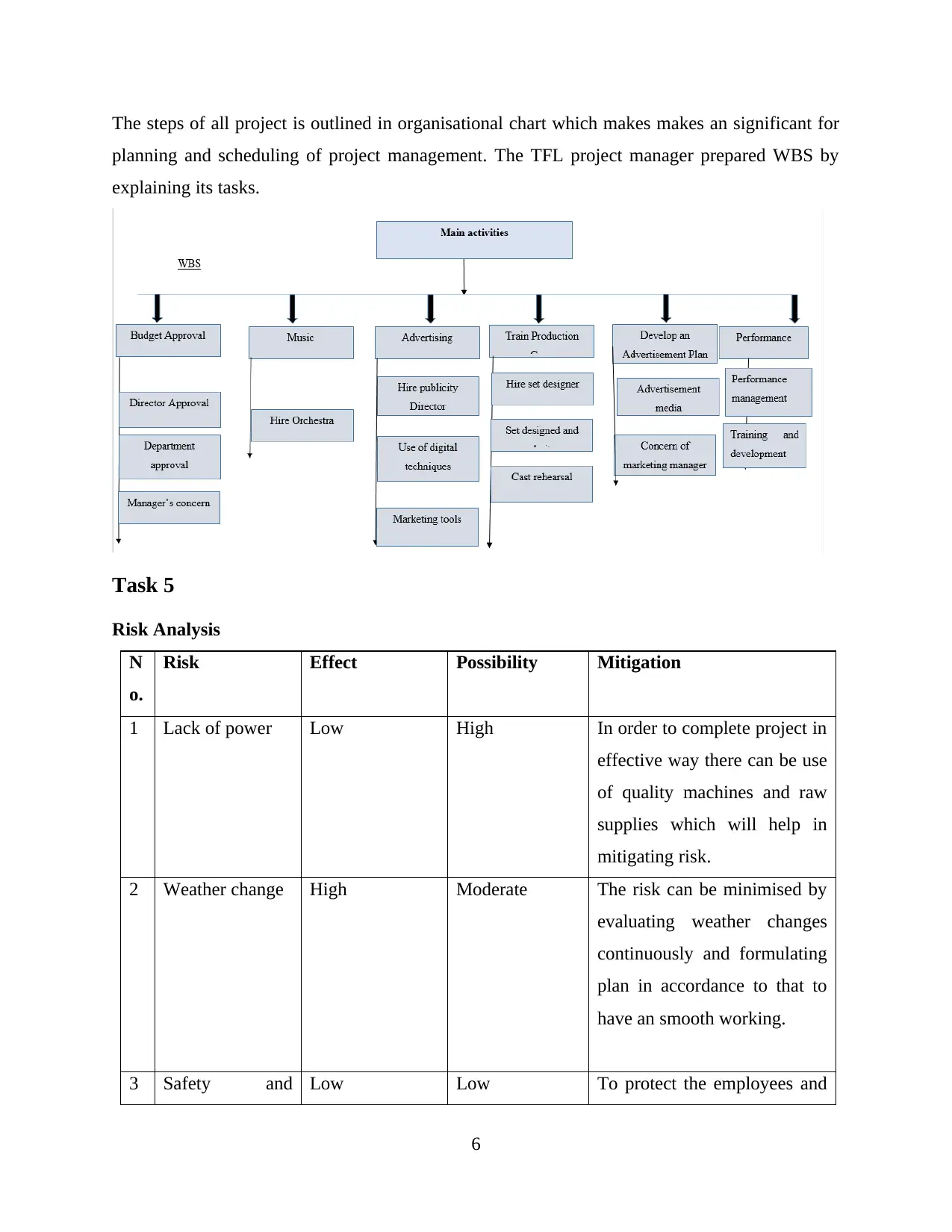
The steps of all project is outlined in organisational chart which makes makes an significant for
planning and scheduling of project management. The TFL project manager prepared WBS by
explaining its tasks.
Task 5
Risk Analysis
N
o.
Risk Effect Possibility Mitigation
1 Lack of power Low High In order to complete project in
effective way there can be use
of quality machines and raw
supplies which will help in
mitigating risk.
2 Weather change High Moderate The risk can be minimised by
evaluating weather changes
continuously and formulating
plan in accordance to that to
have an smooth working.
3 Safety and Low Low To protect the employees and
6
planning and scheduling of project management. The TFL project manager prepared WBS by
explaining its tasks.
Task 5
Risk Analysis
N
o.
Risk Effect Possibility Mitigation
1 Lack of power Low High In order to complete project in
effective way there can be use
of quality machines and raw
supplies which will help in
mitigating risk.
2 Weather change High Moderate The risk can be minimised by
evaluating weather changes
continuously and formulating
plan in accordance to that to
have an smooth working.
3 Safety and Low Low To protect the employees and
6
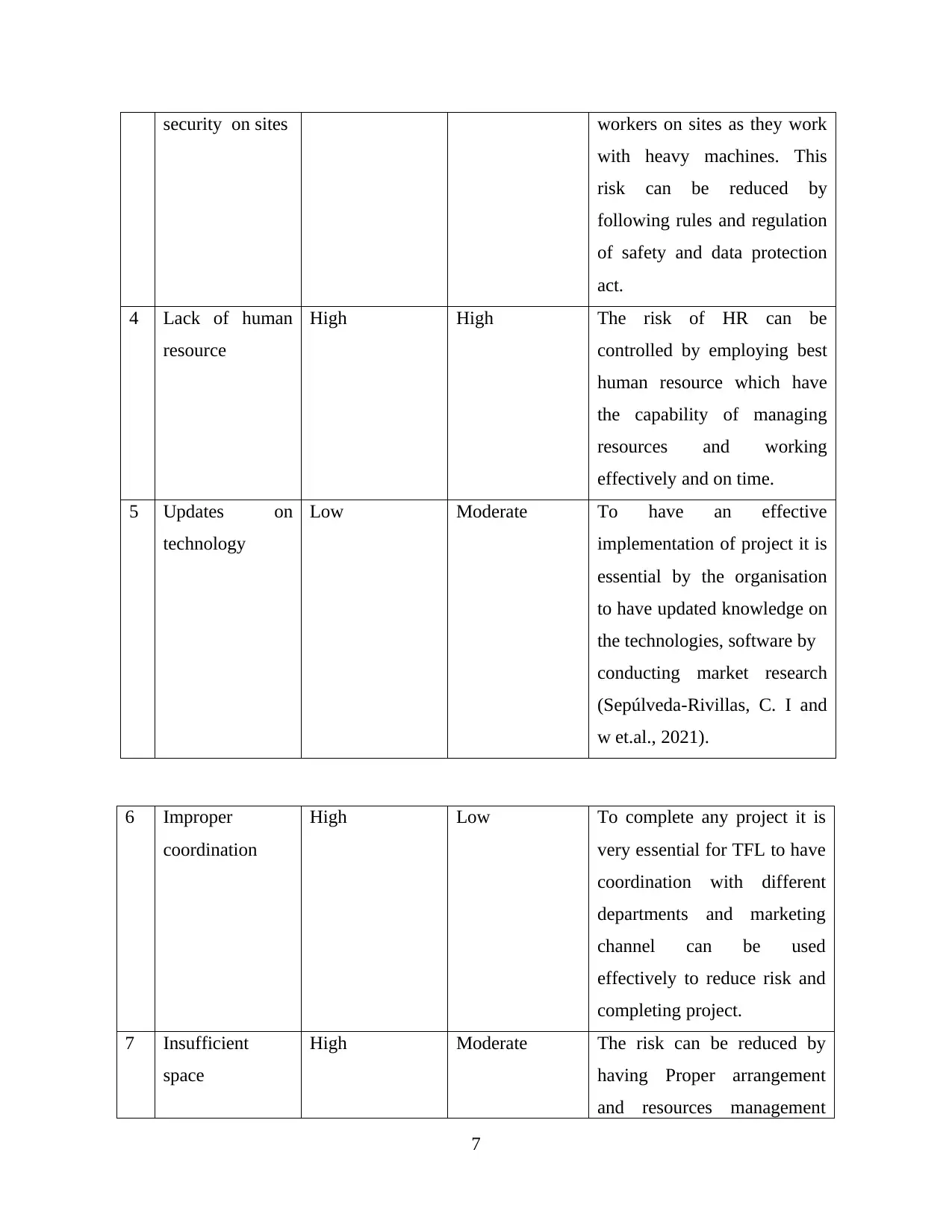
security on sites workers on sites as they work
with heavy machines. This
risk can be reduced by
following rules and regulation
of safety and data protection
act.
4 Lack of human
resource
High High The risk of HR can be
controlled by employing best
human resource which have
the capability of managing
resources and working
effectively and on time.
5 Updates on
technology
Low Moderate To have an effective
implementation of project it is
essential by the organisation
to have updated knowledge on
the technologies, software by
conducting market research
(Sepúlveda-Rivillas, C. I and
w et.al., 2021).
6 Improper
coordination
High Low To complete any project it is
very essential for TFL to have
coordination with different
departments and marketing
channel can be used
effectively to reduce risk and
completing project.
7 Insufficient
space
High Moderate The risk can be reduced by
having Proper arrangement
and resources management
7
with heavy machines. This
risk can be reduced by
following rules and regulation
of safety and data protection
act.
4 Lack of human
resource
High High The risk of HR can be
controlled by employing best
human resource which have
the capability of managing
resources and working
effectively and on time.
5 Updates on
technology
Low Moderate To have an effective
implementation of project it is
essential by the organisation
to have updated knowledge on
the technologies, software by
conducting market research
(Sepúlveda-Rivillas, C. I and
w et.al., 2021).
6 Improper
coordination
High Low To complete any project it is
very essential for TFL to have
coordination with different
departments and marketing
channel can be used
effectively to reduce risk and
completing project.
7 Insufficient
space
High Moderate The risk can be reduced by
having Proper arrangement
and resources management
7
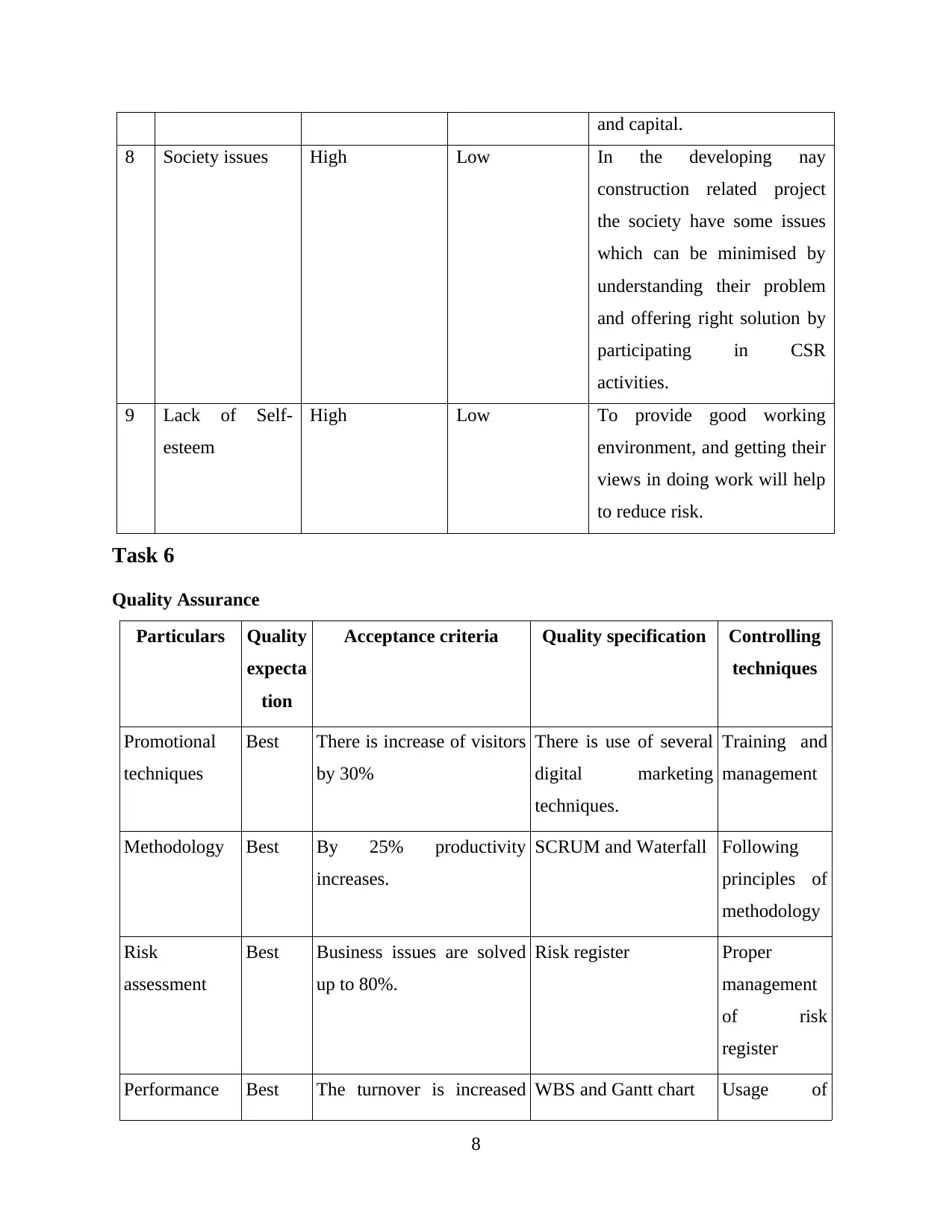
and capital.
8 Society issues High Low In the developing nay
construction related project
the society have some issues
which can be minimised by
understanding their problem
and offering right solution by
participating in CSR
activities.
9 Lack of Self-
esteem
High Low To provide good working
environment, and getting their
views in doing work will help
to reduce risk.
Task 6
Quality Assurance
Particulars Quality
expecta
tion
Acceptance criteria Quality specification Controlling
techniques
Promotional
techniques
Best There is increase of visitors
by 30%
There is use of several
digital marketing
techniques.
Training and
management
Methodology Best By 25% productivity
increases.
SCRUM and Waterfall Following
principles of
methodology
Risk
assessment
Best Business issues are solved
up to 80%.
Risk register Proper
management
of risk
register
Performance Best The turnover is increased WBS and Gantt chart Usage of
8
8 Society issues High Low In the developing nay
construction related project
the society have some issues
which can be minimised by
understanding their problem
and offering right solution by
participating in CSR
activities.
9 Lack of Self-
esteem
High Low To provide good working
environment, and getting their
views in doing work will help
to reduce risk.
Task 6
Quality Assurance
Particulars Quality
expecta
tion
Acceptance criteria Quality specification Controlling
techniques
Promotional
techniques
Best There is increase of visitors
by 30%
There is use of several
digital marketing
techniques.
Training and
management
Methodology Best By 25% productivity
increases.
SCRUM and Waterfall Following
principles of
methodology
Risk
assessment
Best Business issues are solved
up to 80%.
Risk register Proper
management
of risk
register
Performance Best The turnover is increased WBS and Gantt chart Usage of
8
Secure Best Marks with AI Grader
Need help grading? Try our AI Grader for instant feedback on your assignments.
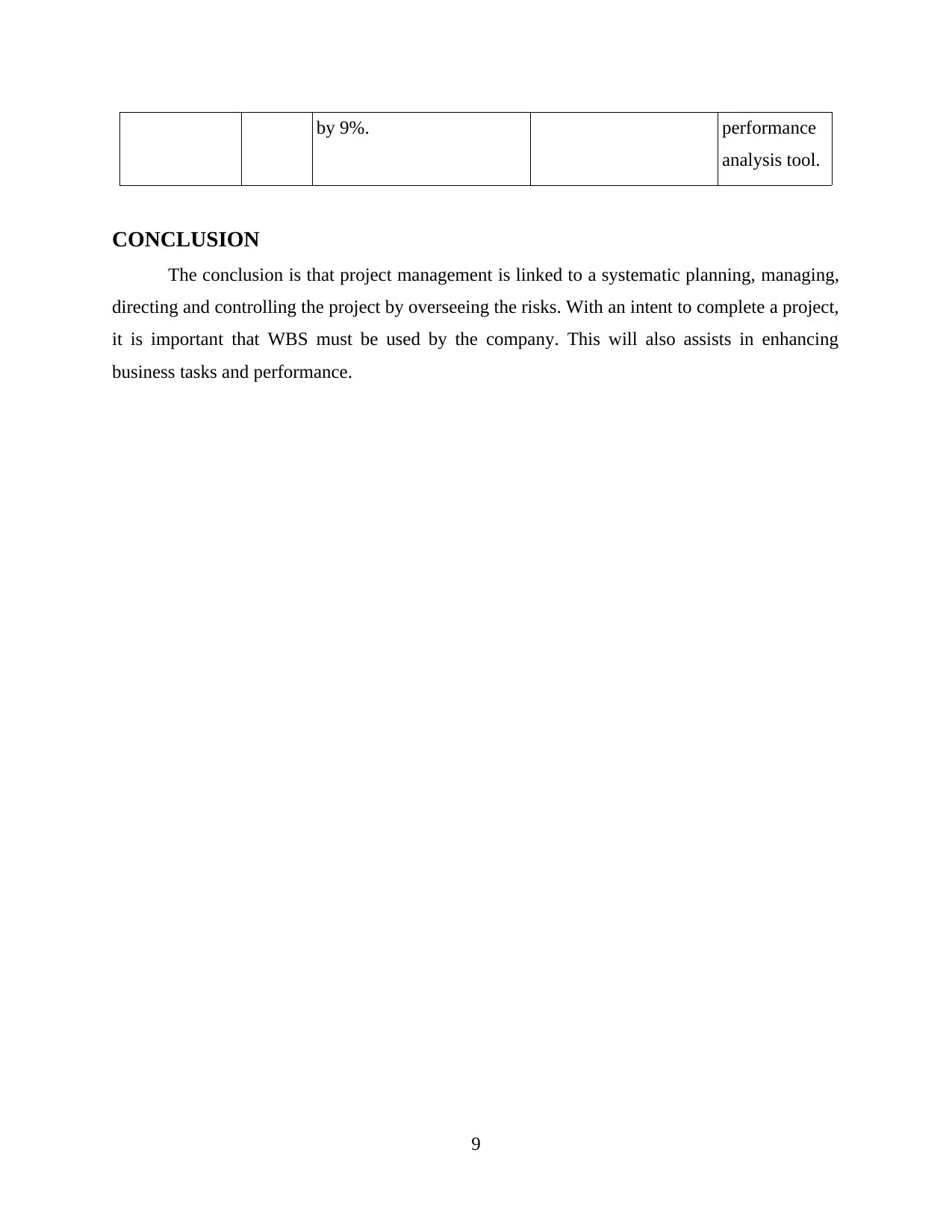
by 9%. performance
analysis tool.
CONCLUSION
The conclusion is that project management is linked to a systematic planning, managing,
directing and controlling the project by overseeing the risks. With an intent to complete a project,
it is important that WBS must be used by the company. This will also assists in enhancing
business tasks and performance.
9
analysis tool.
CONCLUSION
The conclusion is that project management is linked to a systematic planning, managing,
directing and controlling the project by overseeing the risks. With an intent to complete a project,
it is important that WBS must be used by the company. This will also assists in enhancing
business tasks and performance.
9
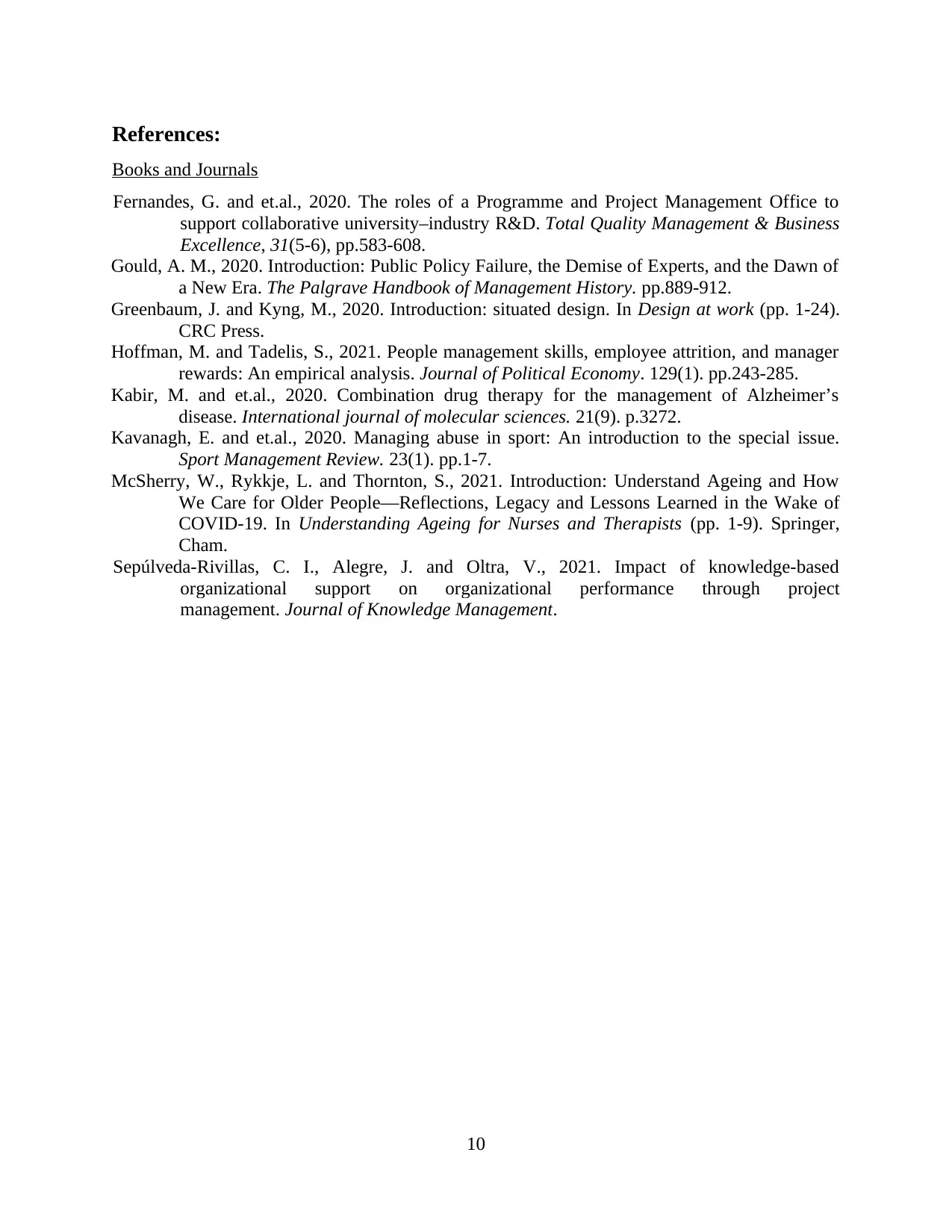
References:
Books and Journals
Fernandes, G. and et.al., 2020. The roles of a Programme and Project Management Office to
support collaborative university–industry R&D. Total Quality Management & Business
Excellence, 31(5-6), pp.583-608.
Gould, A. M., 2020. Introduction: Public Policy Failure, the Demise of Experts, and the Dawn of
a New Era. The Palgrave Handbook of Management History. pp.889-912.
Greenbaum, J. and Kyng, M., 2020. Introduction: situated design. In Design at work (pp. 1-24).
CRC Press.
Hoffman, M. and Tadelis, S., 2021. People management skills, employee attrition, and manager
rewards: An empirical analysis. Journal of Political Economy. 129(1). pp.243-285.
Kabir, M. and et.al., 2020. Combination drug therapy for the management of Alzheimer’s
disease. International journal of molecular sciences. 21(9). p.3272.
Kavanagh, E. and et.al., 2020. Managing abuse in sport: An introduction to the special issue.
Sport Management Review. 23(1). pp.1-7.
McSherry, W., Rykkje, L. and Thornton, S., 2021. Introduction: Understand Ageing and How
We Care for Older People—Reflections, Legacy and Lessons Learned in the Wake of
COVID-19. In Understanding Ageing for Nurses and Therapists (pp. 1-9). Springer,
Cham.
Sepúlveda-Rivillas, C. I., Alegre, J. and Oltra, V., 2021. Impact of knowledge-based
organizational support on organizational performance through project
management. Journal of Knowledge Management.
10
Books and Journals
Fernandes, G. and et.al., 2020. The roles of a Programme and Project Management Office to
support collaborative university–industry R&D. Total Quality Management & Business
Excellence, 31(5-6), pp.583-608.
Gould, A. M., 2020. Introduction: Public Policy Failure, the Demise of Experts, and the Dawn of
a New Era. The Palgrave Handbook of Management History. pp.889-912.
Greenbaum, J. and Kyng, M., 2020. Introduction: situated design. In Design at work (pp. 1-24).
CRC Press.
Hoffman, M. and Tadelis, S., 2021. People management skills, employee attrition, and manager
rewards: An empirical analysis. Journal of Political Economy. 129(1). pp.243-285.
Kabir, M. and et.al., 2020. Combination drug therapy for the management of Alzheimer’s
disease. International journal of molecular sciences. 21(9). p.3272.
Kavanagh, E. and et.al., 2020. Managing abuse in sport: An introduction to the special issue.
Sport Management Review. 23(1). pp.1-7.
McSherry, W., Rykkje, L. and Thornton, S., 2021. Introduction: Understand Ageing and How
We Care for Older People—Reflections, Legacy and Lessons Learned in the Wake of
COVID-19. In Understanding Ageing for Nurses and Therapists (pp. 1-9). Springer,
Cham.
Sepúlveda-Rivillas, C. I., Alegre, J. and Oltra, V., 2021. Impact of knowledge-based
organizational support on organizational performance through project
management. Journal of Knowledge Management.
10
1 out of 12
Related Documents
Your All-in-One AI-Powered Toolkit for Academic Success.
+13062052269
info@desklib.com
Available 24*7 on WhatsApp / Email
![[object Object]](/_next/static/media/star-bottom.7253800d.svg)
Unlock your academic potential
© 2024 | Zucol Services PVT LTD | All rights reserved.